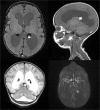The incidence of severe intraventricular hemorrhage based on retrospective analysis of 35939 full-term newborns-report of two cases and review of literature
- PMID: 27392444
- PMCID: PMC5135722
- DOI: 10.1007/s00381-016-3164-5
The incidence of severe intraventricular hemorrhage based on retrospective analysis of 35939 full-term newborns-report of two cases and review of literature
Abstract
Introduction: Intraventricular hemorrhage (IVH) is mostly documented in premature infants, and the younger the gestational age, the more often it occurs. IVH is very rarely reported in full-term neonates.
Case report: Retrospective analysis was performed in 35939 full-term neonates, who were born in the Clinical Hospital of Gynecology and Obstetrics at the University of Medical Sciences in Poznań. Clinical data were retrieved from their medical records. We report a case series of 2 term newborns, who developed severe IVH grade 3 and 4 with no evidence of asphyxia, neuroinfection, TORCH infections, coagulation disorders and trombocytopenia, metabolic disorders, arteriovenous malformations, and selected genetic abnormalities (factor V Leiden 1601G > A polymorphism and MTHFR 677C > T; 1298A > C polymorphisms). IVH in both cases was complicated by posthemorrhagic hydrocephalus treated with decompressive lumbar punctures and next ventriculoperitoneal shunt placement.
Conclusions: In conclusion, several factors influence the predisposition for severe IVH in term neonates. Perinatal period complicated by fetal distress, birth trauma, and severe asphyxia should be taken into account. However, it is possible that etiopathogenesis cannot be defined clearly as in our cases. Cranial ultrasounds in a specific group of term newborns (taking into account risk factors for IVH) should be widely recommended.
Keywords: Etiopathogenesis; Intraventricular hemorrhage; Term neonate.
Conflict of interest statement
None.
Figures


References
Publication types
MeSH terms
LinkOut - more resources
Full Text Sources
Other Literature Sources

